Grade schoolers battle arsenic in water
April 22, 2014

While most people tend to think that the tap water they are drinking is relatively safe and contains no chemicals, it wasn’t the case for the townspeople in Whiteface, Texas.
“The project started out when one of the other team members had done a project over this and found out there was dangerous levels in the water,” Hudson Sanders, Arsenic Arresters members, said.
Recently, a combination of sixth and seventh grade boys, Chad Odufuwa, Brett Wilson, Jeffrey Fortner, Lane Wilson, George Wiebe and Hudson Sanders at Whiteface Middle School tackled this problem with the help of Advisor Laura Wilbanks from Texas Tech University and Dr. William Rodgers, an Associate Professor for Agriculture and Natural Sciences from West Texas A&M University. The team formed five hypotheses to address arsenic in the area.
Arsenic, according to the World Health Organization, is a toxic metal that is a naturally occurring, and a consequence of pesticide use. Arsenic is a known carcinogen and is the number one environmental chemical of concern for human health in the United States and worldwide. To ensure that you have safe and quality water in your own household, you must first know important details like water softener versus a water filter: which one do I need?
“The advisor helps finds professional in the real world hooking up the kids with experts,” Laura Wilbanks, the Advisor to the Arsenic Arresters and science teacher at Whiteface Elementary School, said.
The Lexus EcoChallenge, hosted by Scholastic, is a competition where sixth grade students to high school seniors can team up and enter if they are part of an after-school science or environmental club.
The challenge has two distinct elements: a standards-based, supplementary educational material that encourages teachers to integrate creative lesson plans into their classrooms to help teach students about the environment. The competition also rewards environmental action that helps young people apply what they’ve learned in class through the program and empowers them to make improvements in their community by participating in the environmental team challenges.
“This competition benefits the teacher, school and kids while other competitions do not,” Wilbanks said. “It is unique because it allows for financial backing.”
Lexus encourages young people to make a commitment to making a difference in the world, and for the sixth year, their efforts will be rewarded through the Lexus EcoChallenge.
As an educational program and contest, the Lexus Eco Challenge has inspired and empowered more than 22,000 middle and high school students to learn about the environment and take action to improve that environment. For their efforts, more than $3.5 million has been awarded to students, teachers and schools across the nation.
“I learned that cold water has more arsenic than hot water does,” George Wiebe, member of the Arsenic Arresters, said. “Because the bottom of the tank collects minerals, which kills off the arsenic.”
What brought success to the Arsenic Arresters was initial testing which showed that water from the hot side of the kitchen tap contained less arsenic than the cold side of the tap – this led to the newest idea of developing a water filter for those rural villages in India, where arsenic levels are deadly to the populace, causing many fatalities.
“During the process, we had to wear suits and use special buckets to put the soil in,” Wiebe said. “Then we gave it to the scientist from WTAMU, who then took it to the lab to analyze it.”
Finding a native grassland plants for use in bioremediation of the soil has led to outreach to local and county farmers. This led to the newest idea of obtaining a greenhouse, where native plants could be established and grown year-round – national distribution would occur to aid areas high in arsenic.
“I was very impressed with the maturity the boys had with working with the experts,” Wilbanks said.


